#flying scotsman
Text

#at last I can sleep#don't zoom in too far#there are some wobbly lines because it was drawn on a steam-hauled train lmao#flying scotsman#flying scotsman centenery#gresley a3#preserved british steam locos#british steam#copic markers#actually cheap knockoff copics but who's keeping track#my art owo#going to have nightmares about valve gears for months#flying scotsman ttte#wagahai wa train de aru
208 notes
·
View notes
Text

Late flying Scotsman birthday drawing
#fanart#thomas the tank engine#thomas and friends#ttte fandom#ttte fanart#ttte flying scotsman#flying scotsman#train
116 notes
·
View notes
Text
Fish in An Engine's Tank? It's More Likely Than You Think:
So, recently I wrote a story for my 'The World Famous Engine' fic (read here) which focused on the Flying Scotsman getting fish and weeds into his tanks, which clogged up his injector.
While on the surface, this sounds like a rehash of 'Thomas Goes Fishing' from Season 1, it's actually a rehash of a real-life event that happened to 60103 Flying Scotsman in 1958.
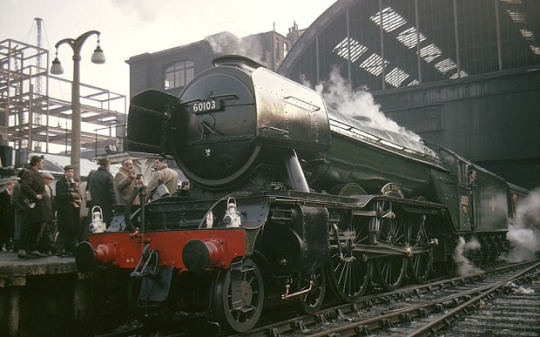
The story of the original incident goes as such: back in the late 1950s, the Flying Scotsman worked on the ex-GCR mainline through Leicester. On the way to London, the injectors failed one after the other, leading to pandemonium on the footplate as they were forced to basically drop the fire at speed and try desperately to get the injectors working again before their engine blew up with a full express. You can imagine their relief when the water started flowing again!
And despite all of this, they were only five minutes late to Marylebone!
The reason for this absolutely frantic and tense few minutes? Well, the outlet pipes from the tender to the injector were protected by wire mesh, which was absolutely clogged with algae and weeds! And then they managed to extract roughly three buckets worth of live fish - and not little minnows, I'm talking bream and rudd - from Flying Scotsman's tender!
And the cherry on top? The fireman, Ken Issett, recalls a lady who said to the crew: "Thank you for my safe journey."

Yeah, this actually happened. The world's most famous engine was very nearly destroyed by some weeds and fish.
But how did the fish get into Flying Scotsman's tender? The answer lies in where railways got their water supply from: anywhere and everywhere. Railways needed a lot of water in an era when pump infrastructure and feed-water was treated a lot less carefully. Furthermore, a lot of railways (in the UK at least) also owned canals, which they would simply take the water from and use. The water was moved to water towers via either gravity or pumps, and then stored before being loaded into the engine's tanks. And the pipes were big, to handle the amount of water required by steam railways.
Some firemen from the era recall using homemade rods to go fishing in tenders and water towers and catching fish! Others recalled the fact that they disliked going into the water tanks to clean and inspect unless they were ordered to. One account literally says:
'The bigger tanks were best, not the smaller side tanks. Better than the canal, though.’
Another said:
‘On Friday afternoons they had trouble finding cleaners because we were all up in the water tank with rafts!’
From this, I'm pretty sure we can all agree that Thomas getting a fish in his tank after having to use a bucket is surprising, not because there was a fish in his tank, but because it wasn't pumped in months ago! Apparently steam locomotives were just massive, unwilling fish tanks.

Considering this, it's a real wonder that there weren't more stories about fish causing an absolute menace on the railways!
For those who want to read the article this is based on, here is the hyperlink and the URL:
#fanfiction writer#weirdowithaquill#railway series#thomas the tank engine#ao3 stuff#ao3 link#real world trains#fish#steam engines are just massive fish tanks#railways#flying scotsman#ttte thomas
95 notes
·
View notes
Text
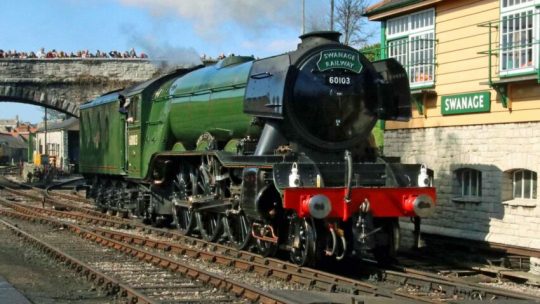
Flying Scotsman at Swanage
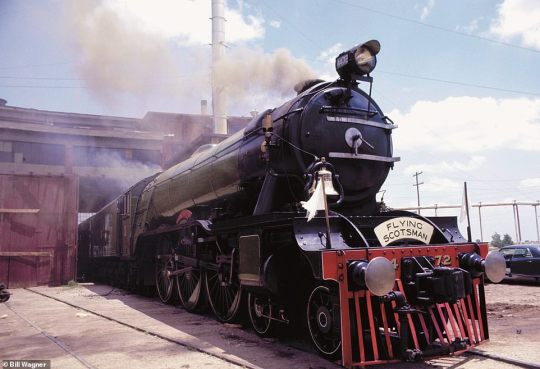
Flying Scotsman in Santa Fe

Flying Scotsman in South Australia with the Broad Gauge , 520 class, Sir Malcolm Barclay-Harvey.
Flying Scotsman in War Livery during NRM rebuild

Flying Scotsman meeting Thomas the Tank

Flying Scotsman meeting Tornado at Carlisle
The many adventures and looks of a beloved 101 year old engine.
#flying scotsman#steam engine#tornado peppercorn#ttte flying scotsman#steam train#on the rails#thomas the tank engine#ttte thomas#steam locomotive#real railway
78 notes
·
View notes
Text

🚂💚 Fancy Green Engines and their fancy Smoke Reflectors 🍏 💨
Wanted to test how I'd add types of smoke reflectors into my humanized (?) mecha (?) designs of engines, so I used as test subjects our dearest Flying Scotsman, Southern's Lord Nelson and LNER's Tornado
#ttte#ttte flying scotsman#lner a1#lner a3#flying scotsman#ttte humanized#humanized engines#mecha design#robot#thomas and friends#wouldn't it be amazing if tornado made it to the show?#lner tornado#mechanized engines
107 notes
·
View notes
Text

The Doncaster brothers sharing one braincell
I’m currently having a Gordon brainrot. And I stumbled across a reel of two fancy dressed men dancing in the funniest way possible. And I had to think of Gordon and Flying Scotsman. So I drew the old men dancing.
#ttte#thomas and friends#ttte human au#ttte humanized#ttte gijinka#ttte gordon#ttte flying scotsman#ttte shitpost#gordon the express engine#gordon the big engine#flying scotsman#these two are so silly#Silly 100 year old men#They are just vibing#Doncaster Brothers
112 notes
·
View notes
Text

Happy birthday Flying Scotsman! :]
#warrior cats#thomas the tank engine#ttte au#ttte warrior cats au#fanart#ttte flying scotsman#flying scotsman
57 notes
·
View notes
Text
You are officially 101 years old so happy birthday to you Flying Scotsman 🎂



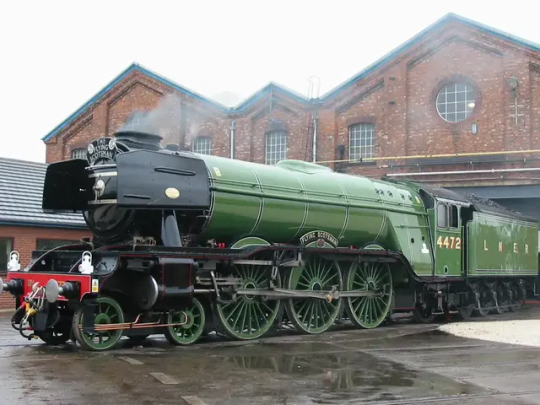
48 notes
·
View notes
Note
So, how does the flying Scotsman get infected?
He came to Sodor immediately after recieving the news that Gordon got very ill. This was before any of the engines fully converted into beasts. After some insistence from Gordon that he was okay, he headed back. But once he reached London, he began acting weird. His crew, heavily suspecting that he contracted the infection, immediately placed him into a shed to isolate him from any other engines. Their speculations were soon proven correct after he entered stage 3.
Miraculously, FS was a bit harmless for the most part after he transformed, but he was very afraid and confused at what had happened to his body. He instantly bolted out of the shed the moment he saw those doors open, accidentally trampling on a few workers and throwing off anyone that tried to get in his cab like a frightened animal.
It took around five weeks to find him, and professional catch-and-release hunters were hired to hunt, tranquilize and bring him back to his shed. Over those weeks, he had been eating wood and small critters to satisfy his new stomach. Luckily, he wasn't spotted in many public spaces, but BBC news had TONS to say about it. FS eventually calmed down and is doing much better. He's still a nuisance to Gordon, even if he's a beast now. It was also discovered he was trying to get to Sodor. FS still won't say why he was trying to get there.
#thomas and friends#thomas the tank engine#monster engines#ttte gordon#ttte flying scotsman#flying scotsman
38 notes
·
View notes
Text

The 1965 Lotus-Ford that Jimmy Clark drove to the 1965 Indianapolis 500 Championship.


Jim Clark was a 2 time F1 World Champion and Indy 500 Champion
Jim Clark died because he was in the wrong place at the wrong time. On 7 April 1968, Clark should have been at Brands Hatch giving the DFV-engined Ford F3L its debut in the BOAC 500 sports car race. But he had been double-booked that weekend, and instead spent it at Hockenheim in Germany for a big European F3 meeting where Lotus was fielding its works team, to oblige sponsors Firestone.
Clark was a sheep farmer from the Scottish Borders who had started competing in sprints in his Sunbeam Mk3 saloon in 1956. He won his first event. He raced friend Ian Scott Watson’s DKW Sonderklasse and Porsche 356 1600 Super before graduating to a Jaguar D-type run by the Border Reivers team.
In 1958 Scott Watson bought one of the first Lotus Type 14 Elites, and at the Boxing Day Brands Hatch race meeting Clark had Lotus founder Colin Chapman in his own Elite all but beaten, until a backmarker spun in front of him.
Clark’s smoothness and mechanical sympathy meant he could often get a Lotus to last a race distance where other drivers could not
By 1960 Clark was a Lotus F1 driver, and he won his first championship race at Spa in 1962. It was one of three wins that year, leaving him in contention for the world championship at the final race of the season in South Africa – but his Lotus failed him, and BRM driver Graham Hill was crowned champion.
There was no mistake the following year. Clark won seven of the 10 races in 1963 – the most any driver had won in one season – and took his first world championship win in dominant style.


Chapman was renowned for building cars that were as light as possible, but often their reliability was suspect. Clark’s smoothness and mechanical sympathy meant he could often get a Lotus to last a race distance where other drivers could not, but it didn’t always work out: in 1964 a strong of retirements robbed him of the chance to defend his F1 title. He was back in 1965 with the new Lotus 33, and six race wins guaranteed him his second world championship.
Graham Hill joined Lotus for 1967 – typically, Clark insisted they were both paid the same salary – and carried out much of the development work on the new Cosworth DFV engine. It was obvious that the DFV-powered Lotus 49 was the class of the field at its debut race at Zandvoort, so Hill and Clark tossed to decide who would win. Hill won the toss, but his car expired, leaving Clark to win – in a car he had never seen before that weekend.
Clark had immense natural ability: he often struggled to understand why other drivers couldn’t keep up
Arguably his greatest race came in the 49 at Monza later that year when he suffered a puncture while leading. The pit stop to change the tyre left him a lap down but he fought past the leading group to unlap himself, belying some commentators’ opinions that Clark wasn’t a racer, and was only any good when controlling a race from the front. He lapped faster and faster, caught up an entire lap, and passed the front-runners again to re-take the lead. But the epic win was not to be: the Lotus ran out of fuel with a couple of laps to go, and John Surtees won in the ‘Hondola’ RA300.
Clark had immense natural ability: he often struggled to understand why other drivers couldn’t keep up. When he had a big enough lead he would keep himself amused by setting the car up in a big slide for the benefit of trackside photographers. His feel for the car was legendary: driving the Lotus 49 for the first time at Zandvoort in 1967 he was convinced something wasn’t right with the car, though there was nothing obvious amiss. But when Team Lotus tore down the car overnight they found one of the wheel bearings was just starting to fail.

Clark won the first F1 championship race of the 1968 season in South Africa, where he beat Juan Manuel Fangio’s all-time record of 24 world championship Grand Prix victories. He was well-placed to win more F1 races and maybe become champion again in 1968, but then came Hockenheim…
His Lotus 48 F2 car was up against a strong international field and Clark was running eighth after the first four laps. On the fifth lap the Lotus headed uphill out of the stadium section of the course and into the woods, was seen to twitch, and flew off the road into the trees. Though the cause of the accident was never established beyond all doubt, it’s likely that a rear tyre failed, possibly due to debris from a previous incident. The Lotus hit a tree, and Clark died from a broken neck and fractured skull. He was just 32.
The whole motor racing community was numb. At Brands Hatch the news was announced to a stunned crowd. Colin Chapman was so destraught he considered giving up motor racing for good. Chris Amon, one of the greatest drivers of his era, summed up the general mood among the drivers by saying if this could happen to Clark, “What chance have the rest of us got?”
The shockwaves from his death were felt not just in Europe, where Clark was a superstar in F1 and touring car racing, but also in the US. Clark had been denied victory in the Indy 500 in dubious circumstances in 1963 but returned, and dominated the race, in 1965 – becoming the first F1 World Champion to win at the Brickyard.
But for a few quirks of fate, Clark could have been F1 champion 1962-1963-1964-1965-1968 and might even have gone on to race and win in the slicks-and-wings era of the early 1970s, which brought two world titles for the Lotus 72. He was, without doubt, one of the greatest drivers ever to race in F1.
Family and community meant a lot to him: his gravestone in Chirnside lists his occupation as ‘farmer’ before ‘World Champion motor racing driver’.
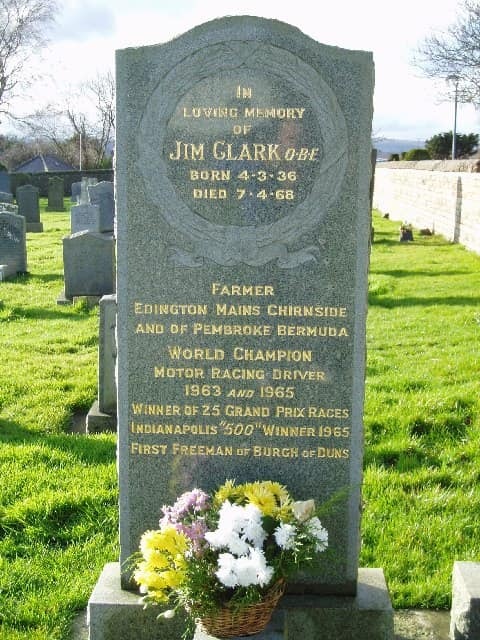
Jim Clark's grave in Chirnside, Scotland.

Jim Clark – winner 1968 Australian Grand Prix at Sandown, Melbourne.

In 1967, Lotus and Cosworth were reshaping the sport of Formula 1 with the assistance of Jim Clark and Graham Hill.

Jim Clark - Lotus 25 - French GP (1965)
French GP, Clermont Ferrand, 27 June 1965 .Winner Jim Clark, Lotus 33 in practice(he raced Lotus 25)

1964 Goodwood TT, Jim Clark, Lotus 30 Ford

The Flying Scotsman Jim Clark
86 notes
·
View notes
Text




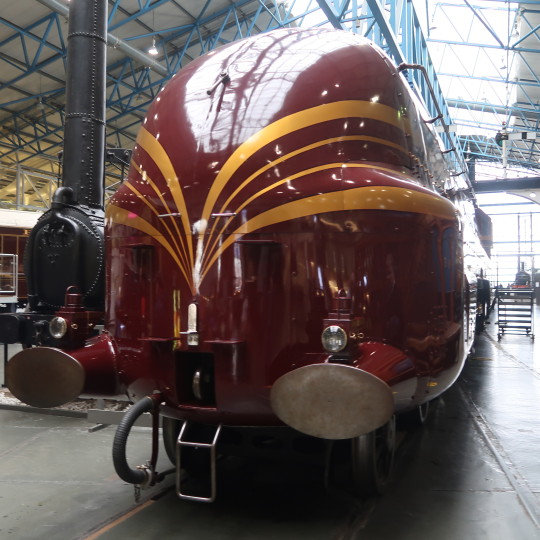



15. 3. 24
National railway museum, York
25 notes
·
View notes
Text

60103 Flying Scotsman is here! 💚🍏🚂
Just a little watercolor sketch of the world's famous steam engine
40 notes
·
View notes
Text

First meeting of the Railway Speed Record Club (1934)
City of Truro (left) and NYC's famous no. 999 (center) were on hand Saturday to congratulate Flying Scotsman (right) on his record-breaking run of 100 mph. Though both engines had claims to the record in the past, this is the first time the achievement has been officially authenticated. There were no hard feelings, however, and all three appeared to be in high spirits over the feat. No telling who the next addition will be to this exclusive club!
(colorized below the cut)

#city of truro#flying scotsman#ttte humanized#nyc 999#my art#ray plays trains#ttte flying scotsman#ttte city of truro
169 notes
·
View notes
Text
Flying Scotsman in 2004 - A Comedy of Errors and Owners:
Ok - so this is something I've been sitting on for a while now, but I feel like with 'The World Famous Engine' now being uploaded to Ao3, now is the right time to cover this rather insane topic. See, we all know the story of Flying Scotsman and the NRM: the NRM bought the engine for the nation, and then sent it into the Works for 1 years' worth of work in 2006... One year of work that ended up spiralling into ten years and £4.2 million.
But behind that story is a rather more shocking story, and one that really needs more recognition to help people understand just how absolutely shockingly Flying Scotsman had been treated before that overhaul.

Sir William McAlpine:
Our story most likely begins under Alan Peglar, but I have a rather sneaking suspicion it actually gets interesting under McAlpine. Sir William McAlpine bought 4472 Flying Scotsman in 1972 to save the engine after Alan Peglar went bankrupt in San Francisco, leaving the engine on a US Military Base.
He brought Scotsman and had the engine restored at Derby Works in England, and then successfully owned and ran the engine for another 23 years, making him the longest-lasting and most successful of all Scotsman's owners.
Pretty good achievement!
But, during this era, Flying Scotsman visited Australia, broke the record for the longest non-stop run by a steam locomotive, pulled the Royal Train, ran on a multitude of heritage railways and mainline excursions, got an overhaul three times - including one at Barrow-in-Furness (story idea, anyone?). This is not where the worst of the issues arose from, but it does give you a good idea of the kind of work this engine was being tasked with.
And then in 1995, it was involved in an accident at Llangollen Railway. When put back into steam, smoke emerged from a crack separating the boiler and the front cab. It was deemed a total failure and immediately withdrawn from service immediately - and that's what did McAlpine in. He sold the engine off to cover some debts, and Tony Marchington
What do I think went wrong here? I have a feeling that Scotsman was run pretty haggard in Australia (which, fair - it's not always a very nice country to machines) and when refitted to his BR livery, several... shortcuts were made to get the engine back in service. All the same, this isn't where the trouble came from.
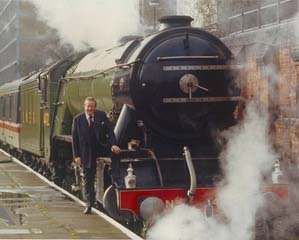
Tony Marchington:
And here's where things went south. Fast. Flying Scotsman was bought, went through a three-year long overhaul worth £1 million and then was set to work. Thing is, that overhaul had a number of red flags surrounding it - perhaps most notable being the fitting of an A4 boiler working at 250psi. Now, for those unaware - the original A1 class ran at 180psi, and the upgraded A3 class ran at 225psi. The engine was being run at a pressure it was extremely unfit to operate with.
It would be a bit like fitting a massive V12 motor to a Honda Accord. Yes, the car will move extremely fast and look impressive and move for a while, but every other piece of that car will deteriorate rapidly due to the pressure it's all under. Now transfer that to a steam locomotive - one where to reach that pressure, the firebox is under a lot of strain.
Flying Scotsman failed a lot during the Marchington era, and it's not surprising why. The poor engine was literally falling to pieces - as one NRM staffmember noted: "On our first inspection, the rear drivers had been removed to deal with bearing problems. The visiting NRM team was most unimpressed with the quality of work being done on the bearings. Other examples of poor workmanship (of which I cannot remember the detail) were evident on inspection.”
Please note, the bearings and valves had all recently been replaced.
Also note, Tony Marchington was under pressure from the shareholders of Flying Scotsman PLC - a company he set up - to make money, and so many of the fitters working on the engine may have been given far, far too many constraints in time and budget to properly overhaul the engine, in essence needing to just 'do the bare minimum to get it back in service'...
And this is the condition the NRM bought 4472 Flying Scotsman in.
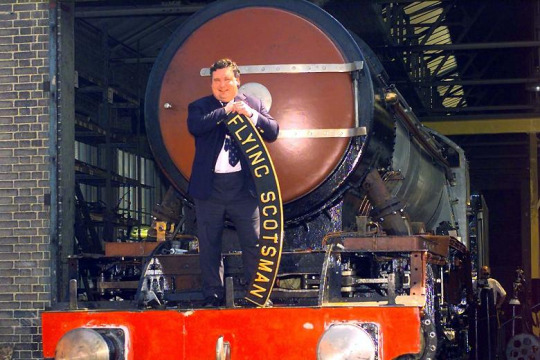
The National Railway Museum:
All of the above is an indication of the condition that Flying Scotsman was in when bought in 2004 - but that only tells about half of the story. The other half is a bunch of issues surrounding the purchase, certification and understanding of just how bad things were. And make no mistake, the NRM is not blameless in this circus - it just managed to inherit a bad situation and then fumble with it until they sat down and figured out what had happened.
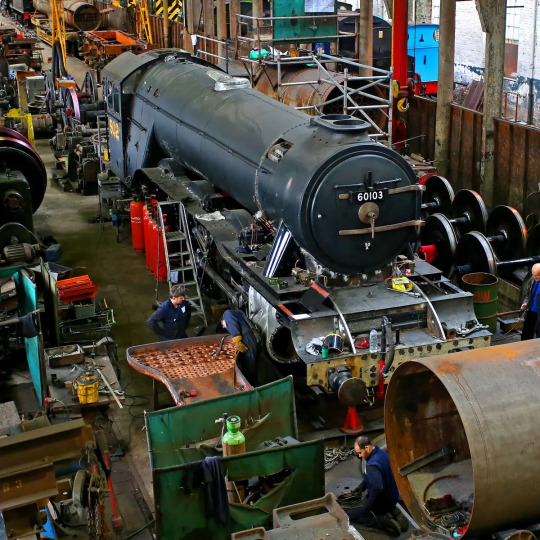
Let's take a moment to look at the AEAT report that the NRM got, then compare it to reality:
The AEAT report stated that:
"Whilst it was not possible to complete a thorough examination of the locomotive, or to witness it in steam, the condition of the locomotive has been monitored regularly as part of the VAB audit process. Taking this into consideration, it is considered that the general mechanical condition is satisfactory for continued operation, subject to effective maintenance, until the next General Overhaul in 2006. The scope of mechanical overhaul is not anticipated to be extensive but will involve strip down of the motion and axleboxes to gauge wear and remedial action. The cylinders all require re-lining and boring to nominal diameter."
The reality of the condition of the engine was far from this rather rosy portrayal given by AEAT. For starters, the engine was not properly examined, and several areas of testing were 'not possibly to be checked adequately' for a variety of reasons, including:
the locomotive was being prepared for a test run
equipment failure
4472 Flying Scotsman not being in steam
Anyone notice something off? Why exactly can the company not see how the engine is when in steam if the engine is being prepared for a test run?

Furthermore, AEAT had been the VAB (Vehicle Acceptance Body) for Flying Scotsman for 14 years by this point and finding a huge number of faults at this point very much would have raised questions about their work. More probably, the company had grown accustomed to the engine working, and simply assumed everything was satisfactory unless demonstratable to the contrary. Like the NRM admitted:
"[T]he previous owner’s VAB may not have been the best choice of inspector."
Thing is, AEAT included pictures in their report, but most of these were of the air brake compressor, locomotive air brake, tender air brake cylinders, TPWS antenna selection switch and the TPWS antenna mounting arrangements, which while critical to obtaining permission to operate on Network Rail, don't say much about the actual condition of the engine. And the photos that were of the actual mechanical parts of the engine were... telling.

The Stay Nuts in the firebox are rusting, melting and missing. And that wasn't the only major issue with the engine - several of which were extremely dangerous:
the Robinson superheater header doors had been seal welded;
other inspection doors had also been seal welded;
Repairs to defective studs on the superheater header were needed;
the smokebox door locking mechanism was broken;
the firebox stays needed caulking;
the boiler mountings and pipework in the cab was considered dangerous;
the air brake reservoirs were overdue re-certification;
two tender springs needed replacing;
Re-metalling one crosshead was needed, which resulted in having to remove the bogie, and led to the discovery that the piston rods were incorrectly fitted to the crossheads and required extensive repairs in order to make them fit properly;
Removal of the 'belly' access door in the bottom of the boiler barrel in order to remove a build-up of some 6 inches of sludge;
one of the tender wheel tyres was flat;
the air pump needed repairs;
the vital axlebox oil pads which were long overdue for replacement;
the tender handbrake just didn't work and needed repairs;
121 boiler tubes needed replacement (2004);
the boiler itself needed replacement (2006);
Foundation ring heavily corroded and cracked;
a large number of latent fractures throughout the whole of the locomotive's frame assembly;
the valves and bearings were faulty or broken;
there was a serious crack in the right-hand cylinder;
the entire firebox itself was in desperate need of replacement;
the boiler washout plugs had been fitted with domestic gas plugs;
the wheels are all in need of re-turning;
the frame hornblocks are all cracked;
one of the driving wheels was bent;
the frame stretchers were all cracked and beyond repair;
The centre-cylinder motion bracket also had cracks;
The frames were wrongly aligned;
And the frame's horn ties were scrap, and needed to be remade.
That is thirty separate issues that the NRM discovered between 2004 and 2012 restoring the Flying Scotsman. The Flying Scotsman needed such a complete overhaul to be restored that some people argued that it would cheaper to just build an entirely new engine.
A completely new version of this engine:
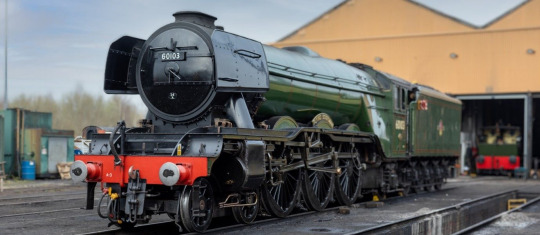
And remember, AEAT certified this engine to run on the mainline. The Flying Scotsman had turned into a literal moving death trap under its various owners, and I am not surprised it cost the NRM £4.2 million to rebuild Flying Scotsman.
In summary, 4472 Flying Scotsman was about as sick as an engine could get when it arrived at the NRM. The amount of work required to fix the poor engine was extensive - and some may argue unjustified. Personally, I disagree. Yes, Flying Scotsman cost a ridiculous amount of money to save and rebuild - but this is not an engine who would ever accept living on a plinth in a museum. This is an engine with a fascinating history filled with trials, tribulations and triumphs; and in my opinion the Flying Scotsman's place is on the mainline. Will there be a day when the old engine has to be withdrawn and placed in the NRM? Probably - it's the oldest mainline certified engine in the UK already, and it's not getting any younger. But by that same token, Flying Scotsman went through a massive, extensive overhaul to ensure that generations to come could see the majestic A3 doing what it always did best, and there's something truly inspiring about that.

A big thank you to the NRM for saving Flying Scotsman, and an even bigger 'what the hell?' to the people who almost destroyed it by being careless.
The pictures used in this post do not belong to me. All pictures belong to their owners. If you wish to read the NRM Flying Scotsman report yourself, this is the URL, and a hyperlink to its archived form on the Wayback Machine:
#weirdowithaquill#railways#real railway stuff#Flying Scotsman#4472 Flying Scotsman#NRM#The National Railway Museum#Flying Scotsman very nearly didn't get his happy ending#There was a lot wrong#this stuff is crazy#long reads#very long post#lner a3#wayback machine
114 notes
·
View notes
Text
Flying Scotsman and some Americans
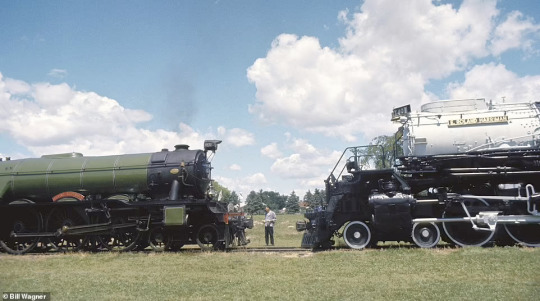



halp plz :(

206 notes
·
View notes
Text
Distant Cousins
"My goodness. The Flying Scotsman! How nice to see you again sir!"
Scott looks to see a purple tank engine speaking with him.
"I'm sorry, do I know you?"
"Oh. My apologies. I'm Ryan. I used to work as a suburban passenger engine out of King's Cross."
Scott comes to a realization.
"Ah yes, the Class N2s. You lot used to bring me the local passengers for my express services."
"Yes indeed. It really is an honor to see you again."
Gordon groans as he rolls into the station.
"What on earth are you doing here? Don't you have a branch line of your own to operate?"
"Sorry Gordon, I'm here to pick up your passengers. You have enthusiasts who want to see the minimum gauge engines right?"
"Of course. But why must you insist that my brother is the biggest celebrity out there? You lot have had to work with us before."
Scott rolls his eyes.
"Now brother, you ought to know that as an N2, Ryan is family."
"Pah! He's about as related to us as the U1 Garrett engines used to be. Just because we have the same designer doesn't make us family."
"I understand that but I at least try to have respect for elder engines. Ryan was after all built before our class."
Ryan backs away as the two bicker. It's pointless to get involved when it's not important anyway.
"Why are you even here, Scott? Shouldn't you be off in a museum somewhere?"
"I asked Mr. Pegler if I can stay here on Sodor for a while to celebrate the 40th anniversary of my non-stop run. He agreed because he thought it would help raise money for my maintenance expenses."
Gordon scoffs. As much as he's glad that Scott's alive, he's still frustrated about the decline of steam.
"To think we were the kings of rail transportation. Someone of our class shouldn't have to beg for money."
"I know. But that's why we need to look out for each other. Ryan's the last of his class and of the original Great Northern Railway engines designed by Sir Nigel Gresley, we are the only ones left."
Gordon takes a deep breath and sighs.
"I know. Still he is our distant cousin. We simply do not interact enough to have any relationship with each other."
Scott smiles a bit.
"But at least we're alive. And that's all that matters."
AN: Thank you for requesting this @nelllia! Expect The Great Race Part 4 to be out soon.
Tagging: @lnwrcauli, @milkagaisme, @asktheoriginalorder, @mintydeluxes-blog, @shadowthebou, @hayleighmccather2001, @tornadoyoungiron, and @slowlykawaiidreamland.
24 notes
·
View notes
